Current Research Trends on Interrelationships of Eco-Innovation and Internationalisation: A Bibliometric Analysis
Abstract
1. Introduction
1.1. Eco-Innovation
1.2. Internationalisation
1.3. Interrelationships of Eco-Innovations and Internationalisation
1.4. Purpose of the Study
2. Materials and Methods
2.1. Stage 1: Search Criteria
2.2. Stage 2: Database Selection
2.3. Stage 3: Data Collection
2.4. Stage 4: Data Analysis
2.5. Stage 5: Presentation of Results
3. Results
3.1. The Output and Growth Trend of Publications
3.2. The Most Cited Publications
3.3. Bibliographic Coupling of Publications
3.4. The Most Cited Journals
3.5. Co-Citation Analysis of Journals
3.6. Co-Citation Analysis of Authors
3.7. Co-Authorship Analysis of Countries
3.8. Keywords
4. Discussion and Limitations
- The bibliometric analysis provided information on the most influential and productive scholars in the research field:
- the most cited publication is by authors E. F. Lambin and P. Meyfroidt with an average of 121.89 citations per year;
- the most-cited journal is Research Policy with a total of 2210 citations, the Research Policy journal is also one of the few most co-cited journals with a total of 1509;
- the most co-cited author is M. Porter (n = 306);
- the country with the largest publication output is the USA (n = 11,518 citations, documents n = 320). Other countries are linked (directly or indirectly) to one of the main countries that are publishing the most scientific documents, thus the data showed that cooperation between authors and countries is mediocre due to the circles’ distance from each other; the circles are widely spread, although they are linked together (directly or indirectly).
- the largest proportion of authors (95.70%) are only credited in one publication;
- a small group of authors (0.73% of all authors) published at least three papers;
- among the journals publishing the topic, only 6.05% of journals published more than 5 documents (from a total of 859);
- among all countries (total n = 112) publishing on a topic, 36.61% countries published over 10 documents;
- a total of 390 publications (23.75% of all publications) was not (yet) cited;
- a total of 18 publications (1.10% of all publications) was cited over 200 times.
5. Conclusions
Author Contributions
Funding
Conflicts of Interest
References
- Bossle, Marilia Bonzanini, Marcia Dutra de Barcellos, Luciana Marques Vieira, and Loïc Sauvée. 2016. The drivers for adoption of eco-innovation. Journal of Cleaner Production 113: 861–72. [Google Scholar] [CrossRef]
- Cainelli, Giulio, Valentina De Marchi, and Roberto Grandinetti. 2015. Does the development of environmental innovation require different resources? Evidence from Spanish manufacturing firms. Journal of Cleaner Production 94: 211–20. [Google Scholar] [CrossRef]
- Cancino, Christian, José M. Merigó, Freddy Coronado, Yasser Dessouky, and Mohamed Dessouky. 2017. Forty years of Computers and Industrial Engineering: A bibliometric analysis. Computers and Industrial Engineering 113: 614–29. [Google Scholar] [CrossRef]
- Chiarvesio, Maria, Valentina De Marchi, and Eleonora Di Maria. 2015. Environmental Innovations and Internationalization: Theory and Practices. Business Strategy and the Environment 24: 790–801. [Google Scholar] [CrossRef]
- Dabić, Marina, Jane Maley, Leo-Paul Dana, Ivan Novak, Massimiliano M. Pellegrini, and Andrea Caputo. 2019. Pathways of SME internationalization: A bibliometric and systematic review. Small Business Economics. [Google Scholar] [CrossRef]
- de Perea, Juan García-Álvarez, Carolina Ramírez-García, and Aida Del Cubo-Molina. 2019. Internationalization business models and patterns of SMEs and MNEs: A qualitative multi-case study in the agrifood sector. Sustainability 11: 2755. [Google Scholar] [CrossRef]
- Deng, Ping, Andrew Delios, and Mike W. Peng. 2020. A geographic relational perspective on the internationalization of emerging market firms. Journal of International Business Studies 51: 50–71. [Google Scholar] [CrossRef]
- Gall, Melanie, Khai Hoan Nguyen, and Susan L. Cutter. 2015. Integrated research on disaster risk: Is it really integrated? International Journal of Disaster Risk Reduction 12: 255–67. [Google Scholar] [CrossRef]
- Genc, Ebru, Mumin Dayan, and Omer Faruk Genc. 2019. The impact of SME internationalization on innovation: The mediating role of market and entrepreneurial orientation. Industrial Marketing Management 82: 253–64. [Google Scholar] [CrossRef]
- Głodowska, Agnieszka, Bożena Pera, and Krzysztof Wach. 2019. International Strategy as the Facilitator of the Speed, Scope and Scale of Firms’ Internationalization. Central European Management Journal 27: 55–84. [Google Scholar] [CrossRef]
- González-Ruiz, Juan David, Sergio Botero-Botero, and Eduardo Duque-Grisales. 2018. Financial eco-innovation as a mechanism for fostering the development of sustainable infrastructure systems. Sustainability 10: 4463. [Google Scholar] [CrossRef]
- Henley, Andrew, and Meng Song. 2019. Innovation, internationalisation and the performance of microbusinesses. International Small Business Journal: Researching Entrepreneurship. [Google Scholar] [CrossRef]
- Hojnik, Jana, Mitja Ruzzier, and Tatiana S. Manolova. 2018. Internationalization and economic performance: The mediating role of eco-innovation. Journal of Cleaner Production 171: 1312–23. [Google Scholar] [CrossRef]
- Inanoglu, Hulusi, and Michael Jacobs, Jr. 2009. Models for Risk Aggregation and Sensitivity Analysis: An Application to Bank Economic Capital. Journal of Risk and Financial Management 2: 118–89. [Google Scholar] [CrossRef]
- Juniati, Sri, Mohd Haizam Mohd Saudi, Eriana Astuty, and Norhisham Abdul Mutalib. 2019. The impact of internationalization in influencing firm performance and competitive advantage: The mediating role of eco-innovation. International Journal of Supply Chain Management 8: 295–302. [Google Scholar]
- Korsakienė, Renata, Svajonė Bekešienė, and Šárka Hošková-Mayerová. 2019a. The effects of entrepreneurs’ characteristics on internationalisation of gazelle firms: A case of Lithuania. Economic Research-Ekonomska Istrazivanja 32: 2864–81. [Google Scholar] [CrossRef]
- Korsakienė, Renata, Vratislav Kozak, Svajonė Bekešienė, and Rasa Smaliukienė. 2019b. Modelling internationalization of high growth firms: Micro level approach. E+M Ekonomie a Management 22: 54–71. [Google Scholar] [CrossRef]
- Kuo, Tsai-Chi, and Shana Smith. 2018. A systematic review of technologies involving eco-innovation for enterprises moving towards sustainability. Journal of Cleaner Production 192: 207–20. [Google Scholar] [CrossRef]
- Liao, Yi-Chuan, and Kuen-Hung Tsai. 2019. Innovation intensity, creativity enhancement, and eco-innovation strategy: The roles of customer demand and environmental regulation. Business Strategy and the Environment 28: 316–26. [Google Scholar] [CrossRef]
- Lopes Santos, David Ferreira, Maite Dubugras Valente Rezende, and Leonardo Fernando Cruz Basso. 2019. Eco-innovation and business performance in emerging and developed economies. Journal of Cleaner Production 237. [Google Scholar] [CrossRef]
- Marcus, A. Alfred. 2015. Innovations in Sustainability. Cambridge: Cambridge University Press. [Google Scholar] [CrossRef]
- Martínez-Román, Juan A., Javier Gamero, María de Loreto Delgado-González, and Juan A. Tamayo. 2019. Innovativeness and internationalization in SMEs: An empirical analysis in European countries. Technological Forecasting and Social Change 148: 119716. [Google Scholar] [CrossRef]
- Mi, Lili, Xiao-Guang Yue, Xue-Feng Shao, Yuanfei Kang, and Yulong Liu. 2020. Strategic Asset Seeking and Innovation Performance: The Role of Innovation Capabilities and Host Country Institutions. Journal of Risk and Financial Management 13: 42. [Google Scholar] [CrossRef]
- Munodawafa, Russell Tatenda, and Satirenjit Kaur Johl. 2019. A systematic review of eco-innovation and performance from the resource-based and stakeholder perspectives. Sustainability 11: 67. [Google Scholar] [CrossRef]
- Nguyen, Phuong V., Hien Thi Ngoc Huynh, Hoa Doan Xuan Trieu, and Khoa T. Tran. 2019. Internationalization, Strategic Slack Resources, and Firm Performance: The Case Study of Vietnamese Enterprises. Journal of Risk and Financial Management 12: 144. [Google Scholar] [CrossRef]
- Ociepa-Kubicka, Agnieszka, and Piotr Pachura. 2017. Eco-innovations in the functioning of companies. Environmental Research 156: 284–290. [Google Scholar] [CrossRef] [PubMed]
- Organisation for Economic Cooperation and Development (OECD). 2009. Sustainable Manufacturing and Eco-innovation: Towards a Green Economy. Policy Brief, 1–8. [Google Scholar] [CrossRef]
- Paraschiv, Dorel Mihai, Estera Laura Langă, and Claudia Olaru. 2011. Exploring Eco-innovation Trends in the European Construction Sector. Focus on Romania. The Romanian Economic Journal 14: 69–88. [Google Scholar]
- Paraschiv, Dorel Mihai, Estera Laura Nemoianu, Claudia Adriana Langă, and Tünde Szabó. 2012. Eco-Innovation, Responsible Leadership and Organizational Change for Corporate Sustainability. Amfiteatru Economic Journal 14: 404–19. [Google Scholar]
- Pedro, Eugénia, João Leitão, and Helena Alves. 2018. Back to the future of intellectual capital research: A systematic literature review. Management Decision 56: 2502–83. [Google Scholar] [CrossRef]
- Priede, Janis, and Elisabeth T. Pereira. 2015. European Union’s Competitiveness and Export Performance in Context of EU—Russia Political and Economic Sanctions. Procedia—Social and Behavioral Sciences 207: 680–89. [Google Scholar] [CrossRef]
- Przychodzen, Justyna, and Wojciech Przychodzen. 2015. Relationships between eco-innovation and financial performance—Evidence from publicly traded companies in Poland and Hungary. Journal of Cleaner Production 90: 253–63. [Google Scholar] [CrossRef]
- Qi, Wenhao, Zhixiong Huang, Hasan Dinçer, Renata Korsakienė, and Serhat Yüksel. 2020. Corporate Governance-Based Strategic Approach to Sustainability in Energy Industry of Emerging Economies with a Novel Interval-Valued Intuitionistic Fuzzy Hybrid Decision Making Model. Sustainability 12: 3307. [Google Scholar] [CrossRef]
- Ratten, Vanessa. 2018. Eco-innovation and competitiveness in the Barossa Valley wine region. Competitiveness Review: An International Business Journal 28: 318–31. [Google Scholar] [CrossRef]
- Shearmur, Richard, David Doloreux, and Anika Laperrière. 2015. Is the degree of internationalization associated with the use of knowledge intensive services or with innovation? International Business Review 24: 457–65. [Google Scholar] [CrossRef]
- Spaini, Carolina, Paresa Markianidou, and Asel Doranova. 2018. EU Eco-Innovation Index 2018. Technical Note. Technopolis Group. Available online: https://ec.europa.eu/environment/ecoap/sites/ecoap_stayconnected/files/ecoi_index_eu_2018_technical_note.pdf (accessed on 10 January 2020).
- Vahlne, Jan-Erik, and Jan Johanson. 2013. The Uppsala model on evolution of the multinational business enterprise—From internalization to coordination of networks. International Marketing Review 30: 189–210. [Google Scholar] [CrossRef]
- van Eck, Nees Jan, and Ludo Waltman. 2017. Citation-based clustering of publications using CitNetExplorer and VOSviewer. Scientometrics 111: 1053–70. [Google Scholar] [CrossRef]
- van Nunen, Karolien, Jie Li, Genserik Reniers, and Koen Ponnet. 2018. Bibliometric analysis of safety culture research. Safety Science 108: 248–58. [Google Scholar] [CrossRef]
- Van Raan, Anthony F. J. 2014. Advances in Bibliometric Analysis: Research Performance Assessment and Science Mapping. In Bibliometrics: Use and Abuse in the Review of Research Performance. Edited by Wim Blockmans, Lars Engwall and Denis Weaire. Wenner-Gren International Series; London: Portland Press Ltd., vol. 87, pp. 17–28. [Google Scholar]
- Wang, Bing, Su-Yan Pan, Ruo-Yu Ke, Ke Wang, and Yi-Ming Wei. 2014. An overview of climate change vulnerability: A bibliometric analysis based on Web of Science database. Natural Hazards 74: 1649–66. [Google Scholar] [CrossRef]
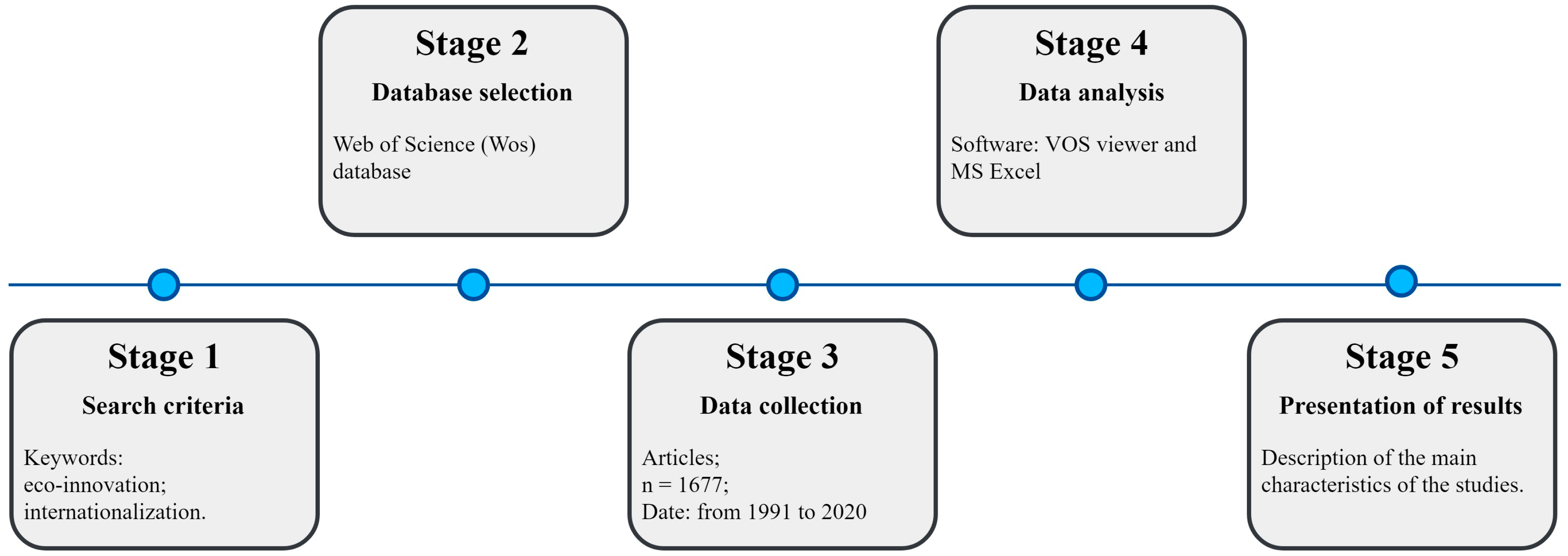

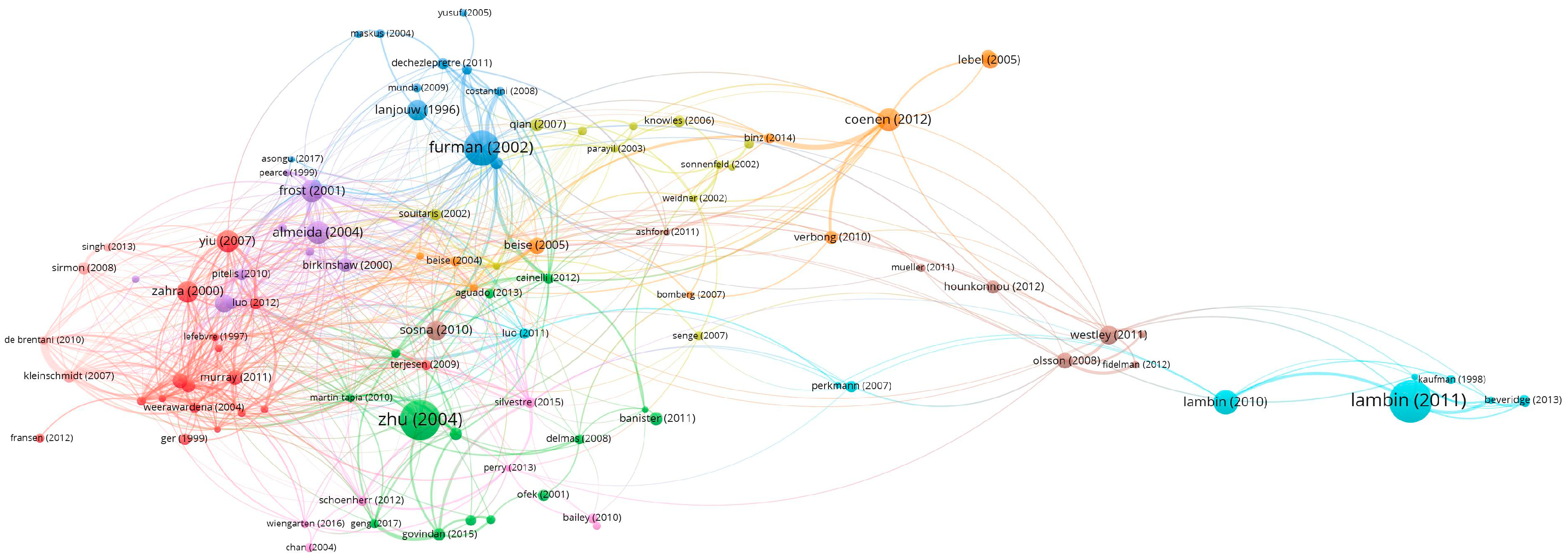
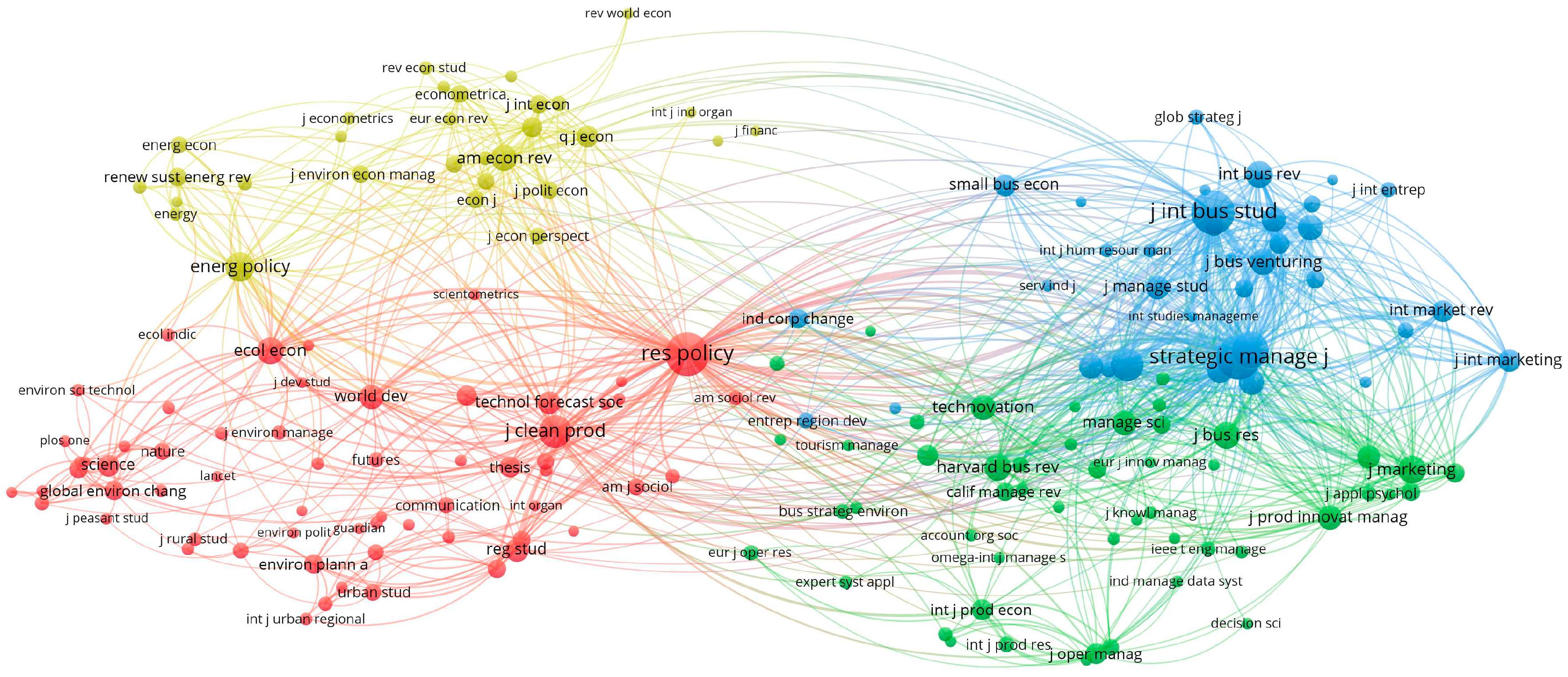


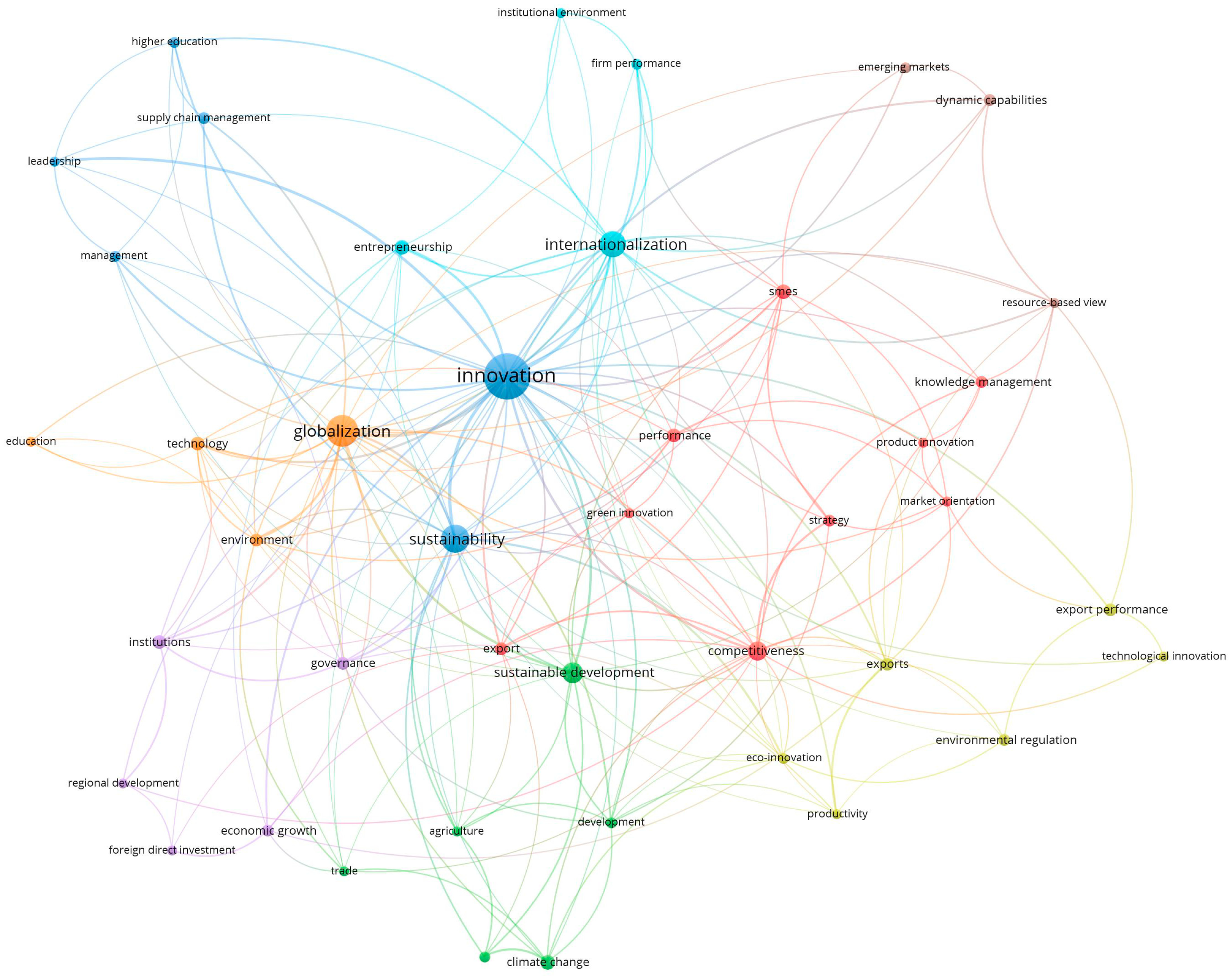
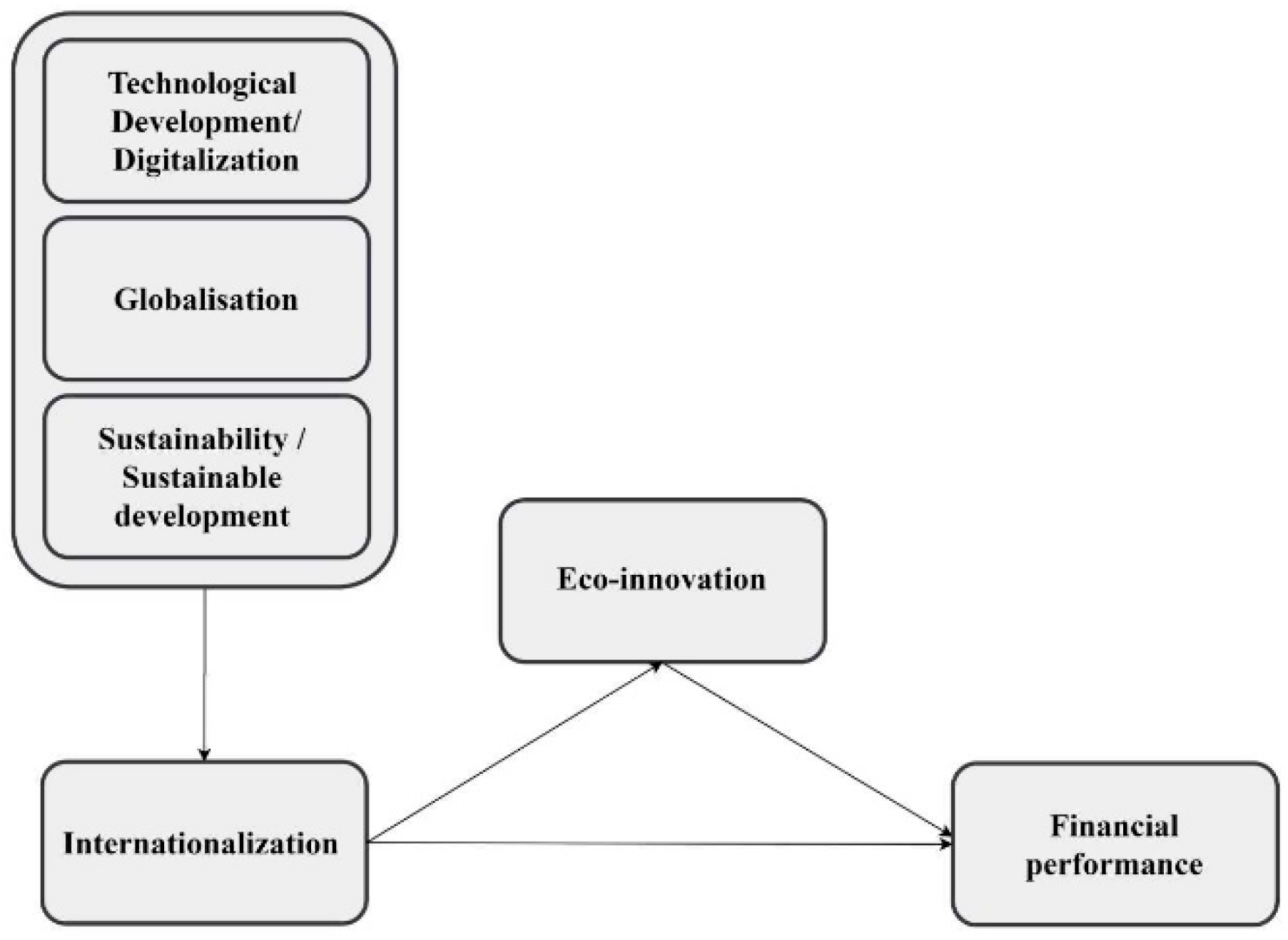
| Title | Author(s) | Journal | Y/C * |
|---|---|---|---|
| Global land-use change, economic globalization, and the looming land scarcity | E. F. Lambin and P. Meyfroidt | Proceedings of the National Academy of Sciences of the United States of America | 2011/1097 |
| Relationships between operational practices and performance among early adopters of green supply chain management practices in Chinese manufacturing enterprises | Q. Zhu and J. Sarkis | Journal of Operations Management | 2004/999 |
| The determinants of national innovative capacity | J. L. Furman, M. E. Porter and S. Stern | Research Policy | 2002/803 |
| Land use transitions: Socio-ecological feedback versus socio-economic change | E. F. Lambin and P. Meyfroidt | Land Use Policy | 2010/435 |
| Toward a spatial perspective on sustainability transitions | L. Coenen, P. S. Benneworth and B. Truffer | Research Policy | 2012/390 |
| Subsidiaries and knowledge creation: the influence of the MNC and host country on innovation | P. Almeida and A. Phone | Strategic Management Journal | 2004/386 |
| International venturing by emerging economy firms: the effects of firm capabilities, home country networks, and corporate entrepreneurship | D. W. Yiu, C. Lau and G. D. Bruton | Journal of International Business Studies | 2007/375 |
| The geographic sources of foreign subsidiaries’ innovations | T. S. Frost | Strategic Management Journal | 2001/362 |
| International corporate entrepreneurship and firm performance: The moderating effect of international environmental hostility | S. A. Zahra and D. M. Garvis | Journal of Business Venturing | 2000/332 |
| Innovation and the international diffusion of environmentally responsive technology | J. O. Lanjouw and A. Mody | Research Policy | 1996/310 |
| Business Model Innovation through Trial-and-Error Learning: The Naturhouse Case | M. Sosna, R. N. Trevinyo-Rodríguez and S. R. Velamuri | Long Range Planning | 2010/305 |
| Tipping Toward Sustainability: Emerging Pathways of Transformation | F. Westley et al. | Ambio | 2011/274 |
| Practical and Innovative Measures for the Control of Agricultural Phosphorus Losses to Water: An Overview | A. Sharpley, B. Foy and P. Withers | Journal of Environmental Quality | 2000/262 |
| Innovative capability and export performance of Chinese firms | J. Guan and N. Ma | Technovation | 2003/254 |
| Lead markets and regulation: a framework for analyzing the international diffusion of environmental innovations | R. Beise and K. Rennings | Ecological Economics | 2005/211 |
| Journal | Documents | Citations | Avg. C. per doc. |
|---|---|---|---|
| Research Policy | 16 | 2210 | 138.13 |
| Proceedings of the National Academy of Sciences of the United States of America | 6 | 1476 | 246.00 |
| Journal of Operations Management | 2 | 1000 | 500.00 |
| Strategic Management Journal | 4 | 763 | 190.75 |
| Land Use Policy | 5 | 566 | 113.20 |
| Journal of International Business Studies | 6 | 553 | 92.17 |
| Journal of Cleaner Production | 37 | 454 | 12.27 |
| Ecological Economics | 8 | 423 | 52.88 |
| Technological Forecasting and Social Change | 16 | 419 | 26.19 |
| Energy Policy | 12 | 393 | 32.75 |
| Journal of Product Innovation Management | 6 | 390 | 65.00 |
| Long Range Planning | 5 | 372 | 74.40 |
| Technovation | 8 | 366 | 45.75 |
| Journal of Business Venturing | 2 | 365 | 182.50 |
| International Business Review | 17 | 361 | 21.24 |
© 2020 by the authors. Licensee MDPI, Basel, Switzerland. This article is an open access article distributed under the terms and conditions of the Creative Commons Attribution (CC BY) license (http://creativecommons.org/licenses/by/4.0/).
Share and Cite
Šūmakaris, P.; Ščeulovs, D.; Korsakienė, R. Current Research Trends on Interrelationships of Eco-Innovation and Internationalisation: A Bibliometric Analysis. J. Risk Financial Manag. 2020, 13, 85. https://doi.org/10.3390/jrfm13050085
Šūmakaris P, Ščeulovs D, Korsakienė R. Current Research Trends on Interrelationships of Eco-Innovation and Internationalisation: A Bibliometric Analysis. Journal of Risk and Financial Management. 2020; 13(5):85. https://doi.org/10.3390/jrfm13050085
Chicago/Turabian StyleŠūmakaris, Paulius, Deniss Ščeulovs, and Renata Korsakienė. 2020. "Current Research Trends on Interrelationships of Eco-Innovation and Internationalisation: A Bibliometric Analysis" Journal of Risk and Financial Management 13, no. 5: 85. https://doi.org/10.3390/jrfm13050085
APA StyleŠūmakaris, P., Ščeulovs, D., & Korsakienė, R. (2020). Current Research Trends on Interrelationships of Eco-Innovation and Internationalisation: A Bibliometric Analysis. Journal of Risk and Financial Management, 13(5), 85. https://doi.org/10.3390/jrfm13050085






